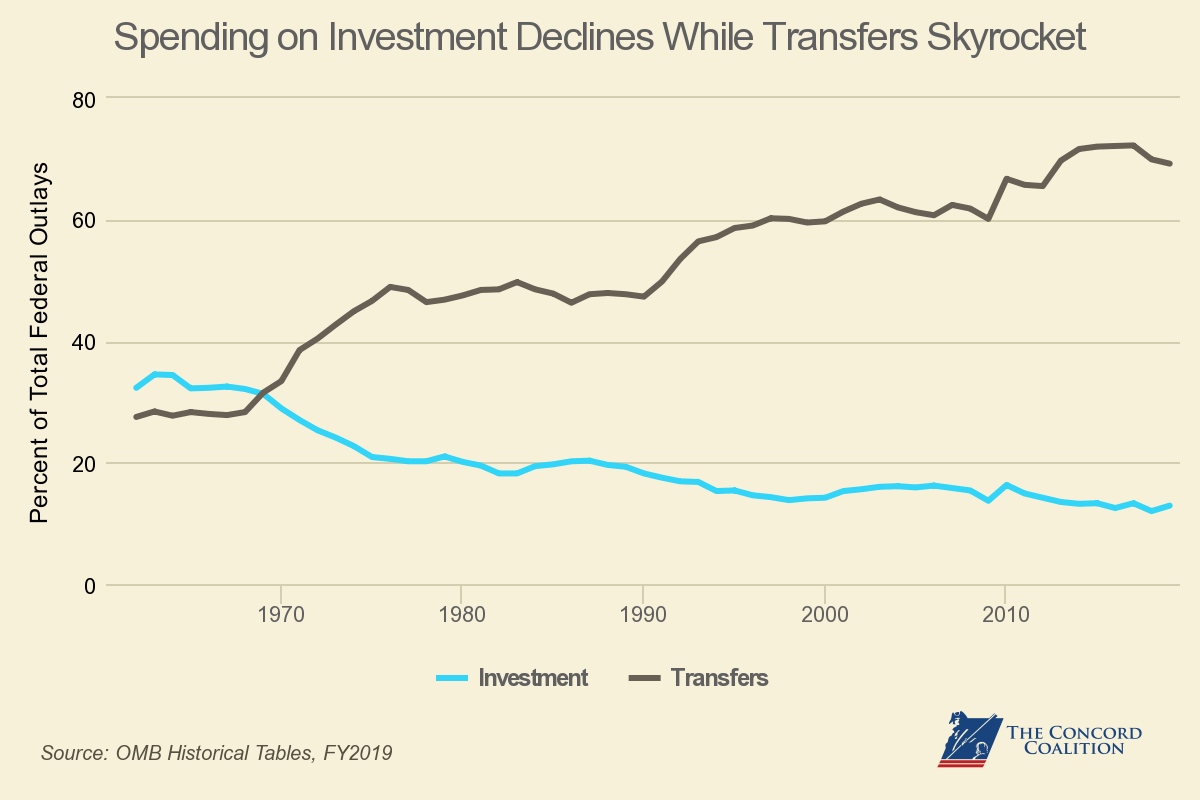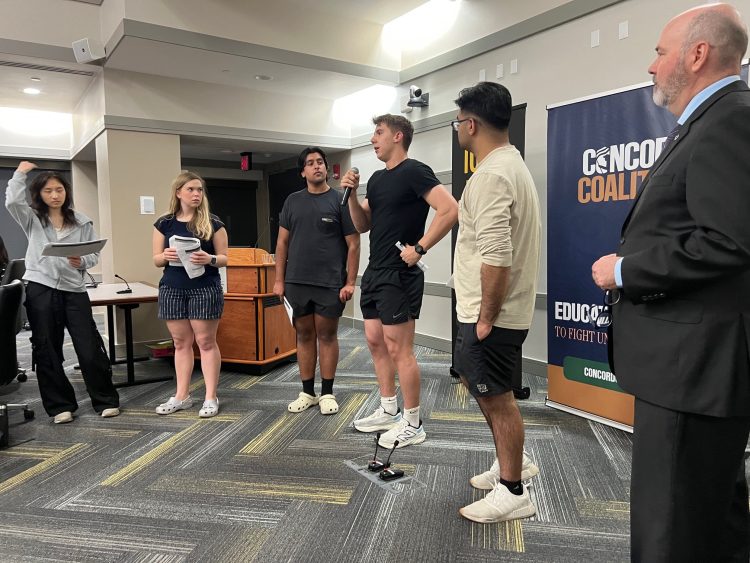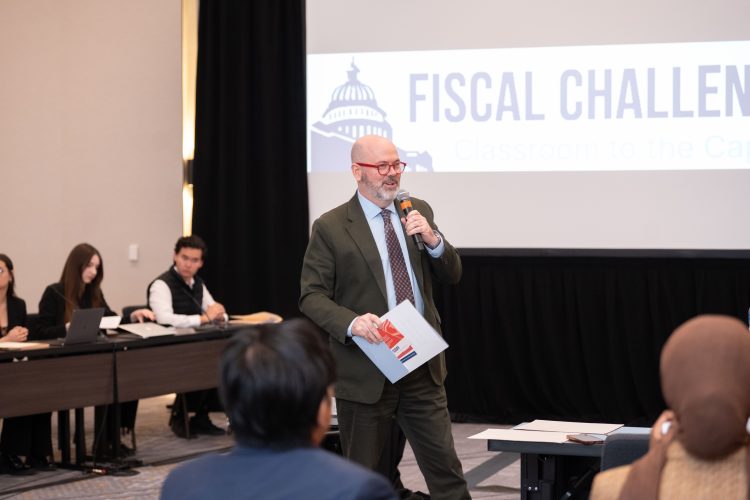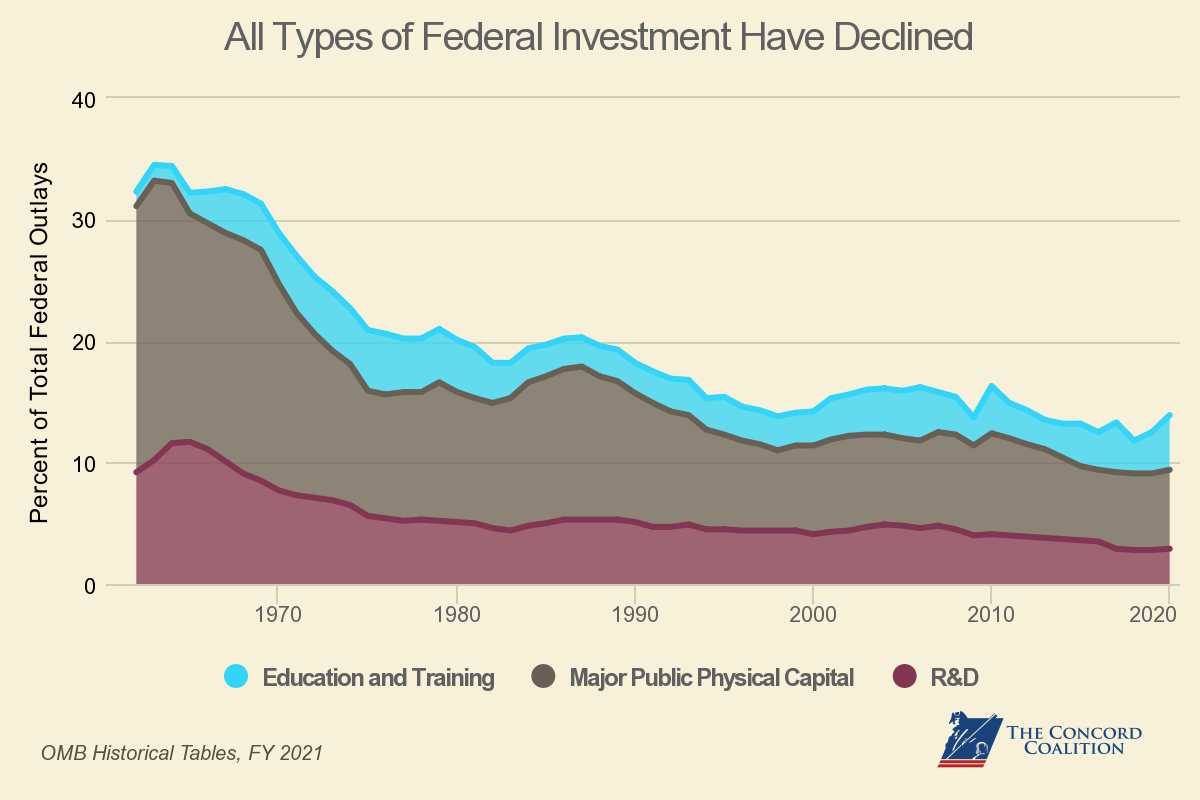Introduction
Recent reports from the Congressional Budget Office (CBO) and the Government Accountability Office (GAO) have reiterated long-standing warnings that the federal budget suffers from a growing structural gap between projected spending and revenues. If left unaddressed, this structural gap will push deficits and debt to unsustainable levels.
Higher economic growth could help close the gap, but here too there are problems. For one thing, no credible growth projection would be enough on its own to put the budget on a sustainable track. More significantly, however, is that the budget also suffers from a growing gap between investment spending, which could add to future economic growth, and transfer payments to individuals.
Over the past several decades, federal investment spending has been trending downward while transfer payments — government programs designed to provide income (or pay bills) in cash or in kind to individuals or families — have steadily grown. This dynamic contributes to lower economic growth projections in the decades ahead because it means we are investing less in the productivity of the workforce even as we expect that workforce to bear the cost of rising transfer payments.
Long-term economic growth depends upon an expanding workforce and higher productivity per worker. Workforce growth is projected to slow substantially due to decreasing birth rates, baby boomer retirements and a relatively steady level of immigration. This has led forecasters to project that economic growth will be lower in future years that it has been in the past. As such, future economic growth will be increasingly reliant on greater labor productivity to make up for at least a portion of the slowdown in the number of new workers. Current federal spending priorities, however, do not reflect this need.
The Importance of Investment Spending to Boost Labor Productivity
Investment in physical and human capital is a key mechanism through which lawmakers can strengthen the economy and promote sustainable growth. While investment stems from both the public and private sectors, the federal government for many years put a priority on investment spending. Federal investments in education, infrastructure, basic science, and research and development, among other initiatives, played a central role in fostering the strong economic growth that the United States has experienced since World War II.
While prioritizing investment, the federal budget historically has also included a range of programs to assist Americans facing challenging economic conditions as well as to prepare hard-working Americans for retirement. Programs like Medicare and Social Security guarantee older Americans a level of financial and medical security. In addition, programs like Medicaid and the Supplemental Nutrition Assistance Program (SNAP) help lower-income households with basic necessities. Through these programs, the government transfers resources in cash or the equivalent to those who qualify.
The balance between investment and transfer spending in the federal budget reflects our priorities as a nation. This balance, however, has markedly shifted in recent decades. Between 1962 and 2017, federal investment decreased by 59 percent as a share of total spending. In the same time frame, government transfers increased by 162 percent as a share of total spending.
These shifts in spending priorities indicate that the federal budget today is less configured to support investment than at any other time in recent history. Why has this dramatic change occurred, and what is its impact on our nation’s fiscal and economic outlook?
Federal Investment Spending Categories and Trends
Federal investment, as defined by the Office of Management and Budget (OMB), is “the portion of Federal spending intended to yield long-term benefits for the economy and the country.”
While the specific definition of investment is a matter of judgement, the federal government takes a relatively broad approach to this spending category. Investment initiatives are primarily “discretionary” programs, meaning Congress can adjust their spending levels each year during the annual appropriations process. Discretionary spending is estimated to account for 31 percent of federal spending in 2018.
Federal investment spending totaled $530 billion in 2017. The OMB categorizes federal investment spending into one of three categories:
-
Public Physical Investment: $252 billion in Fiscal 2017 (48 percent of investments)
Investment spending that funds construction and renovation, purchase of major equipment, and the purchase and sale of land. Physical investment spending supports military efforts as well as major infrastructure initiatives such as transportation, sewage treatment plants, community and regional development, and public housing.
-
Research & Development (R&D): $116 billion in Fiscal 2017 (22 percent of investments)
Research and development investment funds research and other initiatives aimed at fostering innovation and improvement in fields like science, health care, technology, transportation, agriculture and national security. The overwhelming majority of R&D spending goes toward programs run by the Department of Defense (DOD), National Institutes of Health (NIH), National Aeronautics and Space Administration (NASA), and the Department of Energy (DOE).
Research and development spending is split roughly evenly between military and nonmilitary initiatives. Notably, the CBO has reported that defense investment spending provides a negligible amount of positive economic benefits to the private sector. As a result, even less investment spending benefits the economy at large than topline spending levels suggest.
-
Education and Training: $161 billion in Fiscal 2017 (30 percent of investments)
Education and Training include investment spending that funds education and other programs promoting human capital development. Education and training programs include aid for higher education, student loan assistance, education for disadvantaged and disabled youth, and veterans’ education and rehabilitation. Of the total, $57 billion goes to state aid and the rest is for direct federal payments.
Federal investment spending has fallen drastically in recent decades. It accounted for 32.3 percent of the budget in 1962 but a mere 13.3 percent of the budget in 2017.
Physical investment and R&D have suffered especially sharp declines since the 1960s. Physical investment fell from 21.9 percent of the budget in 1962 to just 6.3 percent in 2017. In the same time frame, R&D spending dropped from 9.2 percent to 2.9 percent of total spending. The following chart displays the decline in federal investment spending between 1962 and 2017:
Federal Transfer Spending
Federal transfers are the portion of the budget that, rather than supporting the purchase of goods and services, re-allocates resources in the form of payments to individuals. As opposed to investment spending, which is paid to individuals or firms in exchange for goods or services, transfer programs are essentially check-writing programs run by the government that provide cash transfers to individuals who meet the specified qualifications for each program.
Federal transfer programs span a wide range of policy initiatives run by the federal government, including old-age insurance, medical care, unemployment assistance, federal employee retirement, nutrition assistance, housing assistance and more. Most, but not all, transfer programs fall under the category of mandatory spending, which is estimated to account for 61 percent of federal spending in 2018.
The federal government spent $2.87 trillion on transfers to individuals in 2017, accounting for 72.2 percent of federal spending. The largest transfer programs:
-
Social Security: $939 billion
-
Medicare: $591 billion
-
Medicaid: $365 billion
-
Student assistance: $88 billion
-
Civil service retirement: $84 billion
-
Veterans’ compensation: $79 billion
-
Supplemental Nutrition Assistance Program (SNAP): $70 billion
-
Hospital and medical care for veterans: $68 billion
As federal investments have declined as a percent of total outlays over the past five decades, federal transfers have risen at an even faster rate. Whereas transfers accounted for 28 percent of federal spending in 1962, they accounted for 72 percent of spending in 2017.
Our Shifting Budgetary Priorities
The drastic shifts in federal investment and transfer spending levels in recent decades represent a fundamental modification in how the federal government allocates taxpayer dollars. The following graph displays the arc of this shift in budgetary priorities over the past 55 years:

This shift in spending priorities is predominantly due to the rapid increase in federal spending on the three largest transfer programs: Social Security, Medicare and Medicaid. These programs have grown rapidly in recent years due to the aging of the population and rising health care costs. Consequently, the government is obligated to pay benefits to an increasing number of Americans at a higher cost.
An increasing portion of the federal budget goes to mandatory spending due to rising outlays for Social Security, Medicare and Medicaid. At the same time, discretionary spending — the category under which federal investments fall — has been squeezed.
According to the CBO, discretionary spending is expected to equal 6.4 percent of GDP in 2018 and drop to 5.4 percent over the next 10 years. This would be a noticeable shift compared to its 8.5 percent average over the past five decades. Decreasing discretionary spending overall has caused a corresponding decrease in federal investment spending.
The Trouble With Decreased Federal Investment
Transfer programs play a crucial role in ensuring the financial and medical security for all Americans, and particularly those who are most vulnerable. A federal budget overwhelmingly composed of transfers and little composed of investments, however, does not provide sufficient support for sustainable, long-term growth.
According to the CBO, “R&D, as well as federal investment more generally, increase aggregate economic output mainly by gradually boosting private-investment productivity in the longer term.” Experts in both the private and non-profit sectors concur with the CBO’s assessment of the impact of federal investment. In 2014 testimony before the Senate Committee on Appropriations, Robert D. Atkinson, president of the Information Technology and Innovation Foundation, explained that “low levels of investment mean lower future growth, imposing a hidden tax on future generations.”
As it reduces future economic growth, insufficient federal investment spending dampens our nation’s ability to advance key social causes like public health, infrastructure and technology. The National Institutes of Health — the government’s foremost health research center — has shepherded many of the most influential biomedical innovations of the 20th and 21st centuries, including the creation of over 150 FDA-approved vaccines and drugs. Amply funding the NIH and other R&D programs is a key step lawmakers can take to improve health outcomes.
Investment spending, moreover, provides significant future economic benefits by increasing labor productivity and efficiency. According to the congressional Joint Economic Committee, NIH research yields a rate of return of 25 percent to 40 percent by reducing the economic cost of illness. Conversely, failure to invest sufficiently can dampen economic growth. According to the American Society of Civil Engineers, the U.S. will forego $4 trillion in GDP growth between 2016 and 2025 due to insufficient infrastructure investments.
The economy can use a boost in labor force productivity now more than at any other point in recent history. With workforce growth declining, a boost in productivity could help compensate for at least a portion of the resulting shortfall in economic growth.
According to the CBO’s recent long-term budget outlook, however, productivity will increase by an annual rate of just 1.2 percent over the next 30 years — notably slower than the average annual growth rate of 1.5 percent since 1950.
As CBO explains, “the government’s non-defense discretionary spending is projected to decline over the next decade to a much smaller percentage of GDP than it has averaged in the past. About half of nondefense discretionary spending from the 1980s onward has consisted of federal investment in physical capital (such as roads and other infrastructure), education and training, and research and development—all of which, in CBO’s judgment, contributed to [productivity] growth. Consequently, lower nondefense discretionary spending as a percentage of GDP would mean less federal investment, causing [productivity] to grow more slowly.”
Increased federal investment, in turn, is a much-needed stimulant for the productivity growth necessary to make up for the projected shortfall in population growth.
Conclusion
The balance between federal transfers and investments has shifted dramatically in recent decades, with investment seeing a steady decline and transfers a rapid increase, as a percentage of total federal spending. In 2017, transfers represented 72.2 percent of total spending while investment represented just 13.3 percent of spending.
For the United States to continue experiencing the robust economic growth it has enjoyed since World War II, the federal government must support investment by focusing its outlays on programs that maximize physical and human capital development. In addition, lawmakers must put key transfer programs like Social Security and Medicare on a more sustainable path to ensure their existence for future generations.
By increasing the sustainability of transfer spending and supporting federal investment, lawmakers can better prepare the nation for sustained long-term growth while reaffirming the strength of key transfer programs.
Continue Reading












